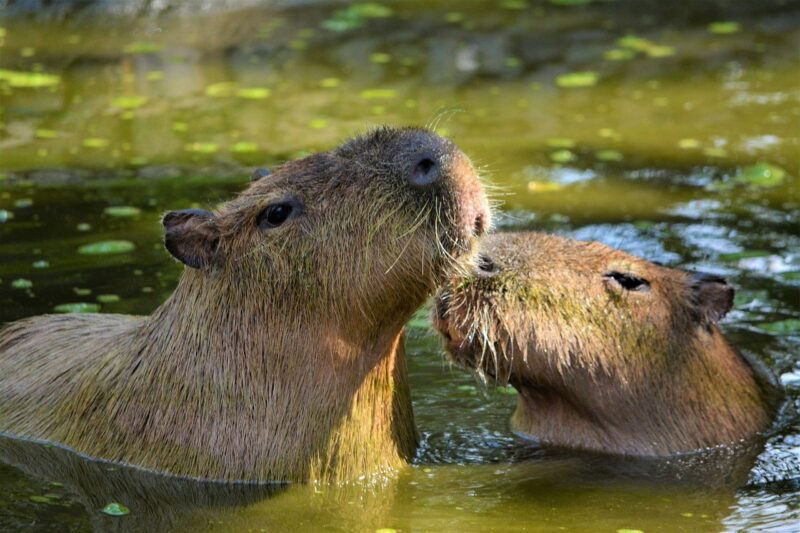Why Capybaras Are Often Called ‘Nature’s Best Friends’ for Their Calm Demeanor
November 13, 2024

Capybaras, the world’s largest rodents, have earned a delightful reputation for their serene and friendly disposition, leading many to call them ‘nature’s best friends.’ These social creatures are native to South America and exhibit behaviors that endear them to a host of other species, including humans. In this article, we will explore the fascinating characteristics of capybaras, their interactions with other animals, and the reasons why they are considered such amicable creatures.
1. Understanding the Capybara: A Brief Overview
Capybaras (Hydrochoerus hydrochaeris) are indigenous to grasslands, savannas, and forests near bodies of water in countries such as Brazil, Venezuela, and Colombia. With an average weight of 100 pounds and a length of up to four feet, they possess a robust, barrel-shaped body and short limbs. Their webbed feet allow for proficient swimming, an essential skill for escaping predators in the wild.
These rodents are herbivores, primarily consuming grasses, aquatic plants, and fruits. They possess a unique digestive system that allows them to extract maximum nutrients from their plant-based diet, making them efficient foragers in their natural habitat.
2. The Calm Nature of Capybaras: What Sets Them Apart
Unlike many animals, capybaras exhibit an extraordinarily calm demeanor, making them a popular choice for pet owners and animal enthusiasts alike. Scientists believe several factors contribute to this tranquility:
- Social Structure: Capybaras are highly social animals that live in groups of 10 to 20 individuals, which provides them with security and companionship. Their communal living fosters an environment of trust and comfort among group members, reducing stress and aggression.
- Grooming Behavior: Grooming is a vital activity within capybara groups. It not only helps maintain their hygiene but also strengthens social bonds, contributing to their peaceful nature.
- Non-Aggressive Instincts: Capybaras are non-territorial and generally avoid confrontations. They rely on flight rather than fight, often choosing to run away from potential threats rather than defend themselves, which fosters a peaceful coexistence with other species.
All these factors create a laid-back animal that rarely poses a threat, making them beloved among other creatures, including humans.
3. Capybara Friendships: Unlikely Companions
Capybaras have become internet sensations due to their interactions with other animals. Their calm demeanor promotes friendships with a variety of species, making for heartwarming imagery and viral videos. Below are some remarkable examples:
- Birds: Capybaras are often seen with birds perched on their backs or around them. Species like herons, plovers, and even smaller parrots benefit from capybaras’ presence by feeding on ticks and insects that can harm the rodents.
- Pet Animals: They are known to interact positively with domestic pets like dogs and cats. Many pet owners have reported their capybaras sharing peaceful, playful moments with their canine and feline companions.
- Other Wildlife: In the wild, capybaras cohabitate peacefully with various species, such as monkeys and crocodiles. Such cohabitation indicates their non-threatening nature, allowing them to coexist with potential predators.
The willingness of capybaras to engage with others showcases not just their calm demeanor but also their adaptability. Their gentle behavior bridges gaps between different species, imbuing the natural world with harmony.
4. Capybaras in Human Culture: Pets and Symbols of Peace
The charm of capybaras has led them to find a place in human culture. Their calm and friendly disposition has resulted in them being adopted as pets in certain regions, particularly in Japan and the United States. Many pet owners report that capybaras can be quite affectionate and enjoy spending time with people, adding to their reputation as ‘nature’s best friends.’
Additionally, capybaras have become symbols of peace and tranquility in various forms of media. From art to merchandise, their serene image serves as a reminder of the harmony that can exist among different beings, encouraging us to foster peaceful relationships, both human and animal.
5. The Conservation Status of Capybaras: Protecting Nature’s Best Friends
While capybaras are not classified as endangered, habitat destruction and hunting pose threats to their populations. Preserving their natural habitat and ensuring sustainable practices is crucial for their survival.
There are various conservation efforts focused on protecting wetlands and promoting coexistence between capybaras and local human populations. By raising awareness and advocating for their protection, we can ensure that capybaras continue to thrive in their natural environments, maintaining their role in the ecosystem as friendly giants.
Conclusion: Embracing Capybaras as Nature’s Best Friends
Capybaras exemplify the essence of harmony in nature. Their calm demeanor, social behavior, and friendly interactions with other species not only endear them to humans but also highlight the importance of fostering peaceful coexistence with wildlife. As we learn more about these remarkable creatures, it’s essential to appreciate and protect them, ensuring that capybaras will continue to be known as nature’s best friends for generations to come. By embracing their peaceful nature, we may be inspired to adopt similar traits in our relationships with others.








